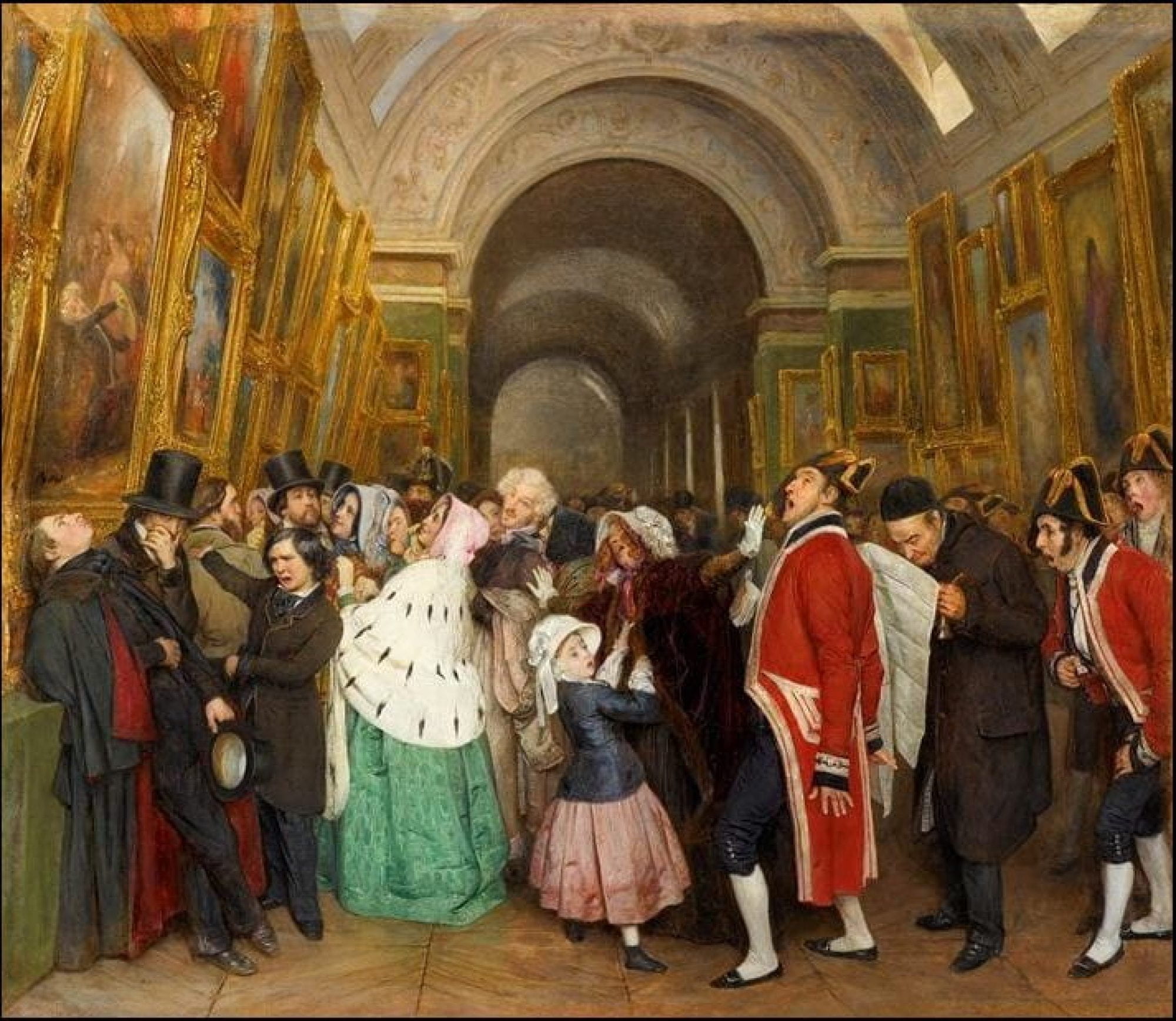Exposing the Intersection of Photography and Sculpture
Emily Lesch shares her creative process, previous exhibitions and upcoming show at Three Legged Goat. Interviewed by Christian Mahoney.
Christian Mahoney: So can you tell me a little bit about how you first got interested in photography and what made you want to pursue it as a major?
Emily Lesch: So it’s actually a very distinct memory. On family vacation, I was bored because I was the only kid. So I took my mom’s camera and just took pictures around the river all day to occupy myself; and I fell in love with it. I was like, “wait, this is so fun.” From then on I just kind of started taking pictures of friends. And I actually went to Blinn in College Station for two years where I just did my general studies. I got all my core classes, took a couple photo classes and I just really wasn’t sure what I wanted to do at that time. However, spending a lot of time on the photo classes there, that’s what I really started to enjoy. I took about every photo class they offered, which was all about three, so I had kind of exhausted my photography education in College Station. So I was like, “time for something new!” and I came to Texas State and I’m so glad I did. I love the place so much.
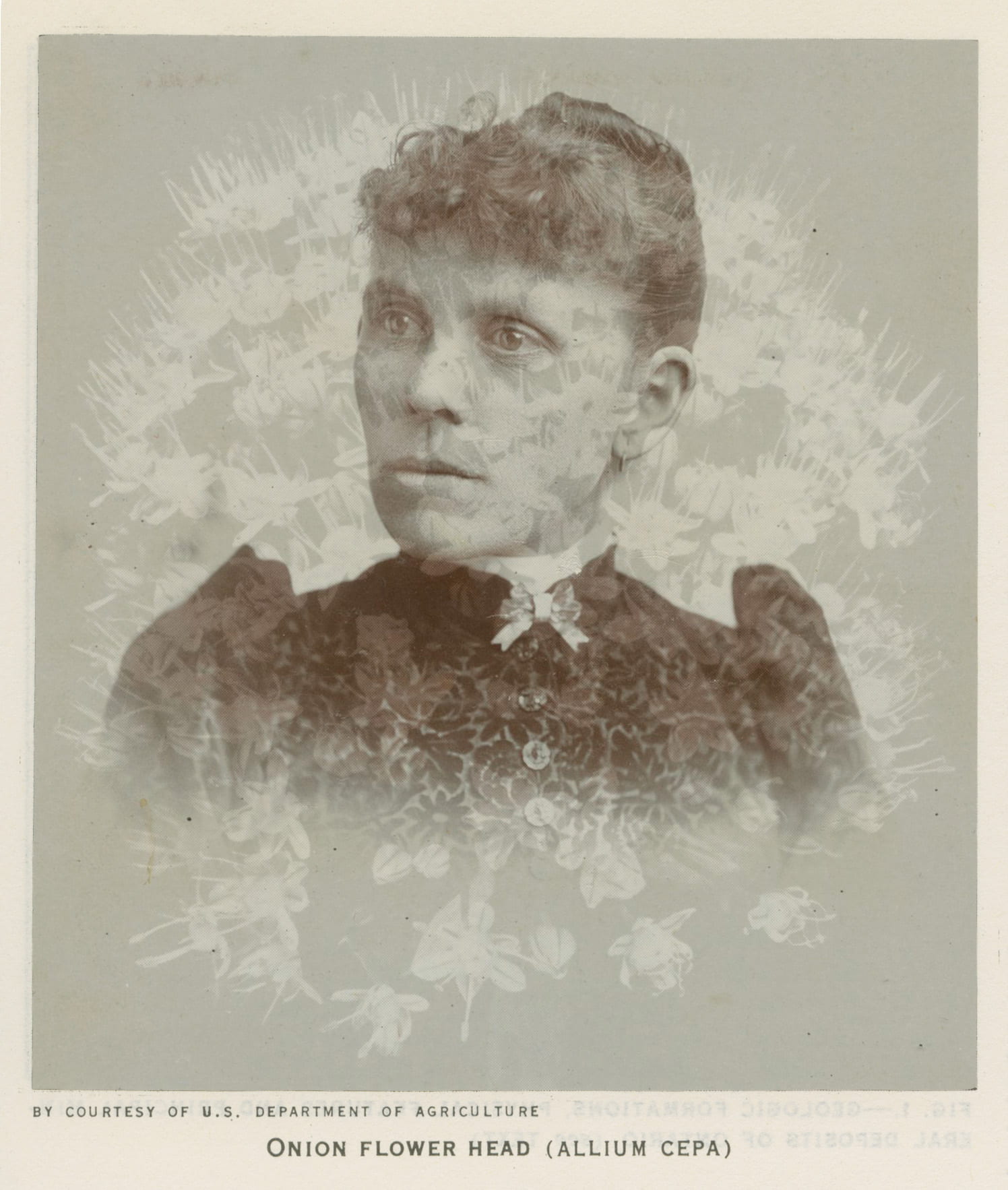 Emily Lesch, Beyond the Layers, digital
Emily Lesch, Beyond the Layers, digital
Your artist statement mentions that you draw inspiration from archival images and documents. Can you talk a bit about what draws you to these sources, and how you go about selecting and working with them in your own work?
Honestly I just kind of go through these pictures and pick random ones that really speak to me. Some of them I’m like, “oh, that’s my grandmother. So I love this picture. She looks really beautiful here.” Others, I’m more drawn to the composition of the way the photograph was taken because there was not a lot of photographic technology back then. To see how they’ve taken such amazing pictures sometimes really draws me in.
There’s this word called punctum. We read about it this year and it’s just kind of the feeling. It means “the feeling that strikes you” and that is what I feel with the photos that I choose to use. Because I’ve got thousands of images at this point to choose from. So I just really kind of sift through them quickly. And the ones that jump out at me and are really like, give me that striking feeling are the ones that I choose to use.
Okay, so they’re not necessarily all family oriented, they’re just kind of historical archive images?
Oh, no, no. They are all family photos. All of the archival work I use is family photos or objects.
And is that just for now or do you plan expanding on that?
That’s a good question. I did one project where I pulled from an encyclopedia, and that was honestly the very first project I did with these archival works. I think I would turn to the archival objects more than the photographs. There’s a lot of cool things that my grandma has, you know, ever since I started this project. Every time I go over there, she’s like, “I’ve got something old for you. I’ve got something old for you.” She thinks that’s what I want. It’s just old things, which is kind of true. Some objects perhaps would find their way into my work, especially with the fact that I like sculpture. I could see that happening.
 Emily Lesch, Vanda, digital
Emily Lesch, Vanda, digital
You mention that you have experience with a variety of mediums, including darkroom development, welding, woodwork, drawing, and painting. How do these other forms of artistic expression influence your photography practice, if at all?
I don’t think painting has really influenced that much of my practice. Darkroom has given me the ability to learn how to use different cameras which use film. So my grandma had gifted me a camera like five years ago which was her father’s in the fifties. I was able to learn how to use this camera and a lot of this thesis project was shot on that camera. Which I find to be so cool because I was able to learn how to do that and I develop all my own film now.
So that’s a great skill. I think that has come to help with this project specifically. That I’m able to use basically any camera that’s given to me and I think it makes the work that much deeper when I’m using something that belonged to my grandmother; just like the photos.
For sculpture, I think it’s really interesting. It gives my work a 3D space. I definitely have found influences in sculpture when it comes to this kind of work because it’s really taught me, you know, you think sculpture and you think 3D, big woodwork, welding, something crazy but it doesn’t always have to be that way. It has taught me that sculpture doesn’t always mean the end product, but a lot of times it means the process to getting there. So in this sense, I was dealing with a 3D encyclopedia ripping pages out, cutting them down, scanning them. There was a whole other aspect to it than just taking pictures and printing them.
Right! There’s a lot of external information that people wouldn’t really get from just viewing your work. Specifically the process of everything. Looking at your internal stuff, it’s easy to see. Someone assuming that it’s family is a fairly easy conclusion to come to, but the external process of making these images and that there is sculpture work in the process would easily be missed.
And did I send you the dress that I made as well? That’s just like another example of how sculpture kind of wove its way into my work. I would think of any way to combine the two.
Yes I thought that was interesting! Can you walk me through your creative process when putting these two mediums together, and how you decide which images to pair with the dress?
They were printed from a laser printer on plain paper in the ADRC at JCM. Then I used essential oils to transfer them, which was really interesting.
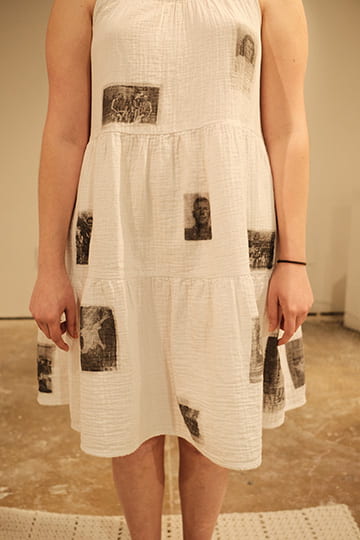 Emily Lesch, The Family Cloth, mixed media
Emily Lesch, The Family Cloth, mixed media
Huh… That’s not what I would’ve expected.
Yeah, it worked great! It was awesome. I just used essential oils and then they transferred pretty nicely.
What’s the process of that?
They had to be a laser print, that’s the only print that’ll work. So then I just kind of soaked it with the oil and it transferred. I would taped it down and then I scraped it with a kitchen tool, lifted it and the picture was there. Think of a temporary tattoo from when we were kids, you know? You used water to put it on your skin. I did the same process just with essential oils.
Okay. That’s cool. Yeah, I wouldn’t have considered that.
Yeah! It was quite fun and sustainable.
What made you wanna put on a dress specifically?
So the title of that piece is called The Family Cloth. I thought originally, like I just kind of wanted some kind of cloth with these photos of my family draped over me, and I spent a while trying to think of it and then, I don’t know, I just chose a dress honestly.
I thought it’d be easy to wear. Something that might not look like it’s a whole art piece at first, it’s kind of subtle. A lot of people didn’t even notice at first that I had made that and that it was photos of my family. They just thought, “oh, cool dress” and I was like, “thanks. I made it!” So I thought the subtlety of it was really nice. It was kind of a conversation starter.
I don’t really know. A lot of my art, I just do.
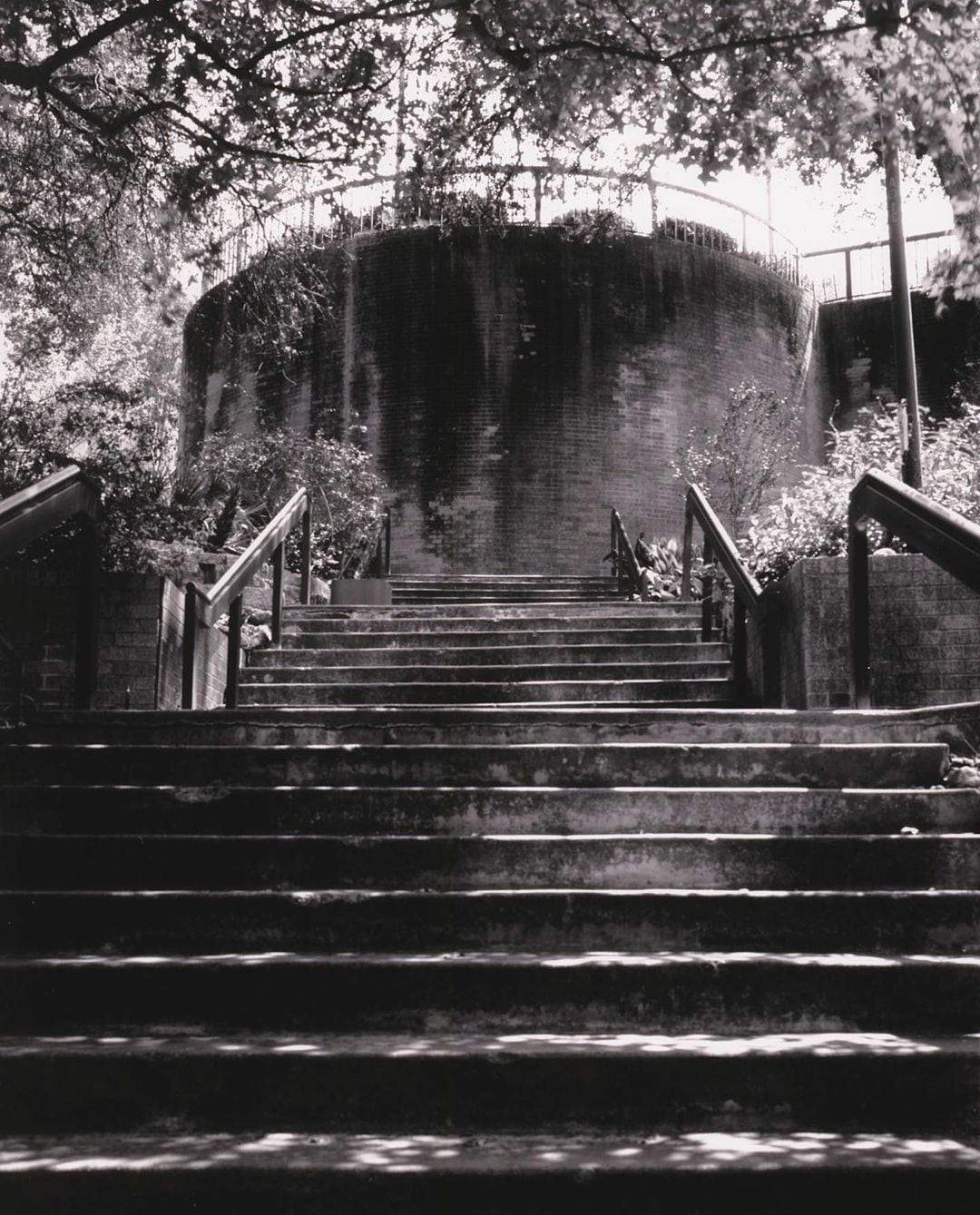
Emily Lesch, Untitled, Film
In your artist statement, you mention that you’ve worked with both archival images and new images of your family members. How do you approach the process of photographing your family members, and how does your relationship to them affect your photography practice?
Oh, that’s a good question. They get annoyed with me, but I just sit there and tell them, “in 30 years when you’re uglier-“, followed by us both laughing. She then added, This is so, please don’t put this word for word in your interview, with a chuckle, But this is honestly what I tell them. I’m so close with my family, but it’s so funny. “In 30 years, When you’re older and uglier, you’re gonna appreciate that I took these pictures of you looking young!” and that’ll get ’em, then they’ll, “Okay, whatever.” I just mostly emphasize how much they’ll appreciate them later. “You’re gonna complain right now, but when you’re old, you’re really gonna love that you have these pictures of you, and all these memories.” And they’re very supportive of my work. They know that a lot of it is for school and for my art.
I think I do want to put that word for word because it comes across well! Mainly because that’s how I am with my family. Like, there’s some like jabs here and there, but it’s a family dynamic, you know?
Yeah! It’s all good fun. And it’s, it’s for the better of it. I mean it with love.
It’s a shame we don’t get a lot of printed photos now. It’s… I don’t know. There’s no drive to do it anymore, it’s all on our phones. You have film, you want to get it developed. Because there are so many photos of my grandfather, his partner and their friends at our family’s ranch in Junction. The photos show them building a ranch house over a few weeks, from nothing to foundation, walls, and eventually playing volleyball and having beer cookouts. It’s a cool, slow progression of how they built something together and changed the land.
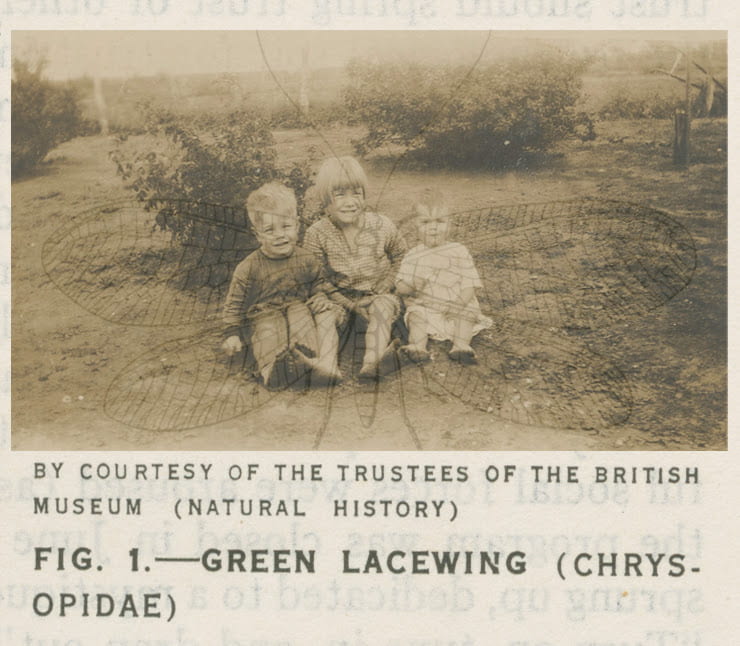 Emily Lesch, Green Lacewing, digital
Emily Lesch, Green Lacewing, digital
How has your upbringing influenced your artistic practice, specifically in regards to your interest in family history and archival images? Because you mentioned your family was very supportive of you and your art.
I’m a big believer that everyone’s very artistic or has the opportunity to be. It bugs me when people are like, “I’m not creative, I’m not artistic.” I think you’re just not trying, everybody has creativity within them, but that being said, I never really got like, “Oh, my mom is a photographer.” So that was kind of never in the picture.
Nobody really understands my art, but they’re supportive. They just want me to be happy. But my mom has always been a scrapbooker. She loves to scrapbook and I think maybe that, deep down, has had a play with some of the aspects of how I display things, collage them and things like that.
As for the archival aspect, I think just being so close with my family and specifically my mom’s side, this work really deals with my mom’s side of the family. When I talk about my family, I’m usually talking about my mom’s side. So just being so close to them, you know, I find all these pictures and I just care. I just care to learn about where they came from, I find it interesting to see what they looked like and what they experienced. My grandfather was military, so they’ve got some interesting stories. One of my aunts was born in Germany because of it, so… I don’t know.
That’s a really hard question in a way, but I’d just say because I’m so close with my family. I wanted to learn about where they came from, which ultimately led to who I am and where I am today. Because, you know, if they hadn’t made this, the decisions that they made back then I wouldn’t be here.
Right. This is an explorative process for you. It’s not something that’s just a one and done thing, or it’s something you already know about. It’s something that you continue to learn from as you do your art. So as you keep doing this kind of art and pursuing what interests you, I feel like that will lead to what can answer this kind of question. You’ll have a more developed meaning from everything once you have more experience with working with it.
I agree. I’m constantly learning from my work.
 Emily Lesch, Epidendrum, digital
Emily Lesch, Epidendrum, digital
As a lab monitor at Texas State University, you have experience working with a variety of students and their photographic projects. What have been some of the most rewarding aspects of that work for you, and how has seeing what other students or teachers do influenced your own photography practice?
One reward is the community that I’ve been able to build. Being there all the time and just having conversations with students I never would’ve met because we will never have a class together but because I work there, I’ve got the opportunity to talk to them. When I help students with equipment I get to see their work, ask questions, and talk about it. In return, a lot of times they wanna talk about my work and I just think building that community has been really nice because you can get different perspectives. You get opportunities too.
I’ve gotten pretty close with a lot of the professors and professors are very giving people. They’re really willing and ready to support you and I’ve found that truly over in the photo lab just by spending so much time there, making friends and connections. I think that that has helped me. Just expanding. I think learning constantly from other people shows in your work and also just the honest skillset that I’ve learned has taught me a lot.
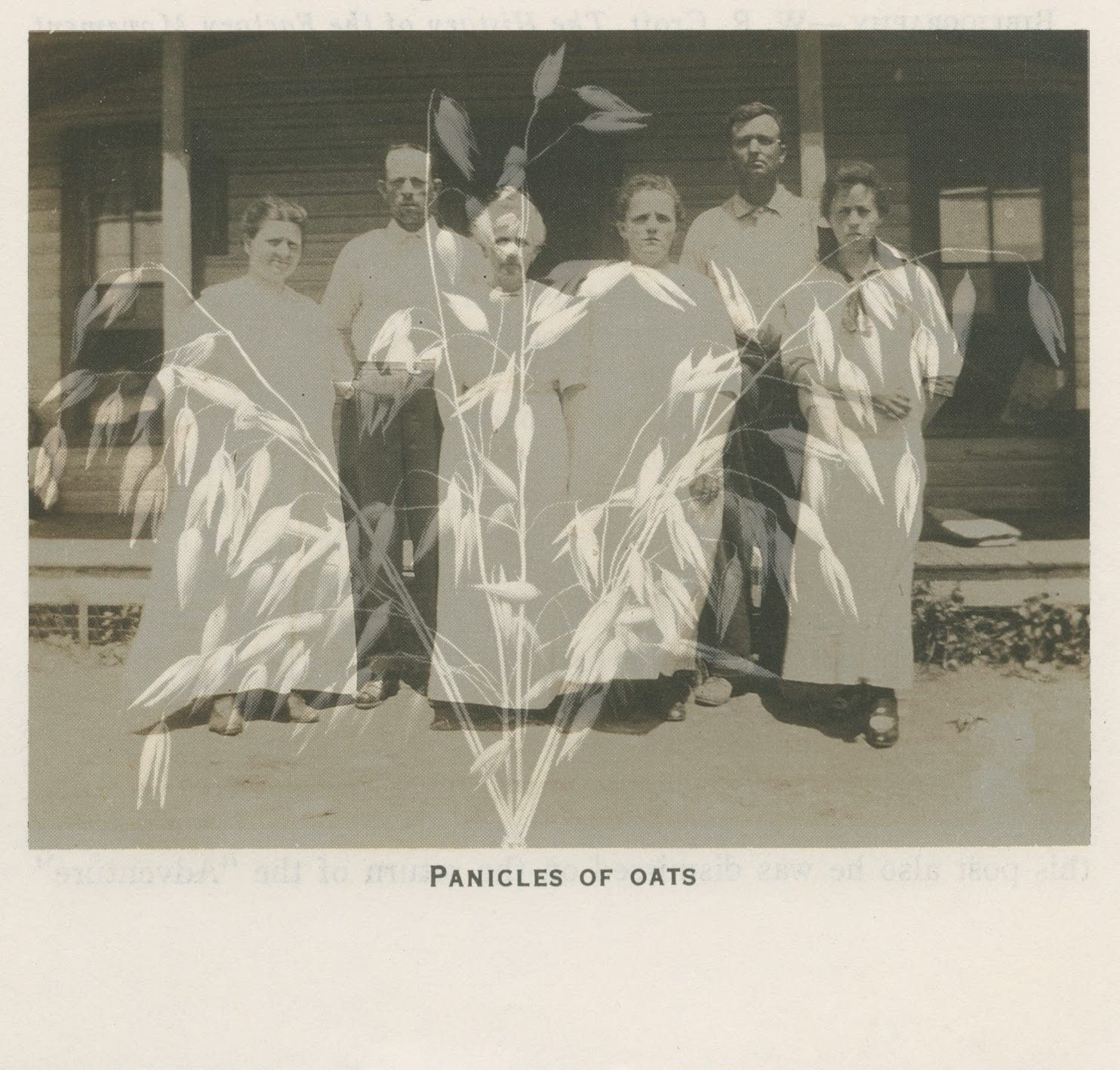 Emily Lesch, Panicles of Oats, digital
Emily Lesch, Panicles of Oats, digital
You mention being inspired by artist Enoch Rios. How has his work influenced your own practice?
I had already been working on my work before. I had been scanning these images and for a while I kind of just kept in my own bubble, making my work. I really didn’t look to other artists for inspiration or to see if other people were doing the same thing. And when we went over to his space, I had no idea what his artwork was like. I went in with open-mindedness. I hadn’t looked into his work. And I found it really interesting when I walked in, I felt like an immediate connection to my work, but in such a different way.
You know, he had done this piece scanning the backs of images, and you and I had kind of talked about that earlier, how much you can learn from the writings on the back of an image and how rewarding that storytelling could be. I thought that was awesome and I really enjoyed his process, which is different from mine because mine deals with my family and people I know. However he dealt with complete strangers and random pictures he found at Goodwill and I thought that was really awesome to see the stories he could make from these people that we don’t know.
That gave me kind of the “go” in my mind that other people will feel that way about my work. Because my work is personal to me, and I find it enjoyable to me because it is my family. But what does someone who doesn’t know me or my family think when they come in and see these photos? So it was rewarding to see that I could feel that about somebody else’s work, that made me feel very hopeful for my work.
Finding another artist that makes work out of photos of people nobody knows and then realizing that people like this, it is an interest to people. It’s not just you’re making these in a bubble for yourself. People will be interested because people love seeing how people were and how those people have changed.
Yeah. It’s reassuring. And then you can just take that and run with it and do your own thing.
Exactly. Yeah. Not being afraid to deviate and being confident in your ideas, the skillsets you have and how you present stuff.
 Emily Lesch, Natural Inclined Collage, instant film
Emily Lesch, Natural Inclined Collage, instant film
You’ve had both solo and group exhibitions. What was it like to prepare for those shows, and how did you go about selecting the work to display?
Yeah, that is a great question because the way my mind works, I’m constantly thinking about my thesis work. So in this upcoming project I always try to think of how I can include my thesis work in any works I’m doing. So if my sculpture professor gives us a prompt I’m thinking how can I merge the photo and the sculpture.
And I think I do the same for those exhibitions. So in this case, our theme was Naturally Inclined and I chose to do a Polaroid series. Mainly consisting of old family photos, mixed with some kind of early two thousand photos, mixed with the last two or three years’ photos that I’ve taken. Those photos include plants, animals, and people, all shot on film. Specifically the way people interact with plants. Because I thought that it was interesting to kind of detail how we’ve interacted with those things over the years and I put them in this universal Polaroid format so that they kind of had this like… Actually. I don’t know. I was gonna come up with some reason why I put them in the Polaroid format, but. I think it’s just aesthetic.
Yeah. It’s a timeless thing that everyone recognizes.
Yeah! That’s it. That’s why I did it.
It’s like a material thing. People, almost everyone has held a Polaroid. Everyone has felt the unique joy of seeing a Polaroid and how it comes out so uh… vintage is not the word I want to use, but the colors are just really good. And they spark a sense of nostalgia, it’s something that everyone recognizes as physical but also as something that has stayed consistent through the years.
Yeah! I’ve actually, in my recent work, been taking pictures with my dad’s Polaroid from high school. The film is almost expensive though.
Back to how I go about selecting my works though, for that group exhibition, since my mind is so focused on this body of work, I’m constantly trying to find ways to make more work for it and fit it into different categories. So that’s how I chose for this group exhibition.
By myself for my first solo show, I honestly just chose my favorite work that I’ve made that I thought people would enjoy. The name being Underexposed was because, I as an artist and my work are underexposed. And well because of the photography term! It’s just kind of all the work I’ve made over the last two or three years and work that I thought people would be willing to buy and put in their home, you know?
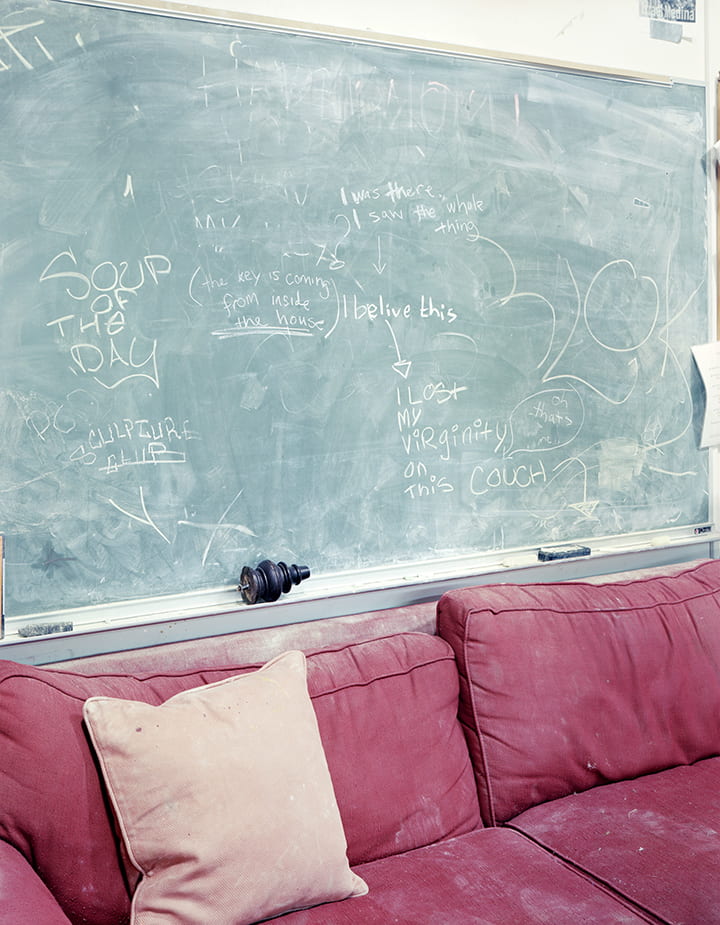 Emily Lesch, Soup of the Day, film
Emily Lesch, Soup of the Day, film
How do you hope your audience will engage with your work and what do you want them to take away from it?
Million dollar question, right? I think that one thing I love about art is that everybody can have their own unique, different experience with every piece of art. I have no control over that. That being said, I just hope that people can relate in some way. I don’t care what the way is, I just hope that people may gain an appreciation for art and photography as a fine art, you know? Like I’ve mentioned several times today, bridging that gap with photography and fine art is a constant battle, and I hope to do that even more with my film work and showing people how much work goes into making an image.
We talked a little bit about this already, but what are some of the biggest challenges you faced with your artistic career, specifically photography, and what have you done to overcome them?
Some of the challenges I face are resources and networking. As far as resources, I am so lucky right now to have school as a resource but all photography equipment is pretty expensive, so I’ve really had to learn how to work with what I have. Honestly that has taught me a lot in the end. That you can still make something so successful without a lot or reusing things. Then the other would be networking.
I find that to sometimes be a struggle for me in that a lot of people only see photographers as people who are only there for weddings, graduations, engagements, and I don’t wanna be known for that per se. So my networking is always kind of centered around that and I struggle a bit to network in the fine art world of photography. Just talking more to people, professors and working as a lab monitor has gotten me that community and resources which allow me to learn and lean on my fellow photographers.
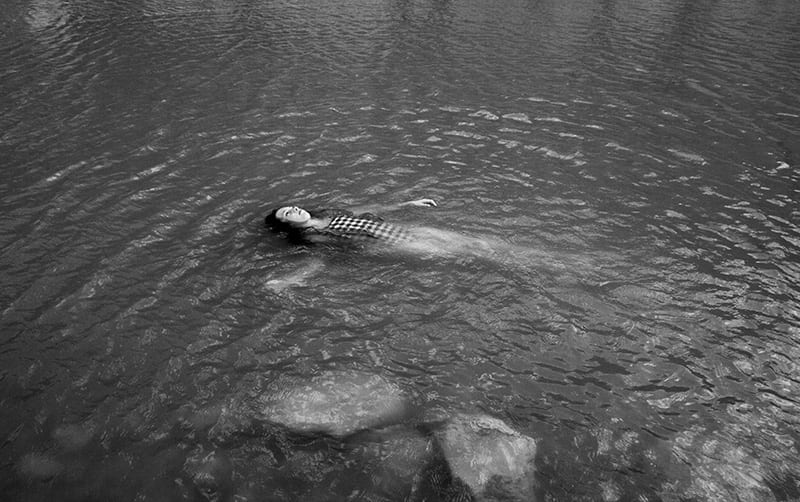 Emily Lesch, As it Should Be, film
Emily Lesch, As it Should Be, film
Looking ahead, what are some goals for your future work, photography and other mediums? How do you see your practice evolving over time and outside of your thesis work?
I graduate in one semester! My plan is to build up my resources at home and get a job outside of my field while also keeping up with my own projects on the side. I’m not one to stress about the future too much – I just go with the flow and let life take me where it takes me. That way, I can keep doing what I love for a long time. I hope to continue working with film, though. That’s a big thing I really want to do.
Do you plan to stay local or would you move somewhere else?
I hope to do some internships and some residencies. Specifically, I really would love to do a residency in South Padre, there’s an art gallery there and it’s a special place to me. I’d love to move there for a little while. Overall though I think I wanna stay close. I’m so close with my family. I couldn’t really see myself leaving, maybe except for a small amount of time, but I think I’ll always find my way back here.
One long-term goal I do have is that I’d love to teach art in some way. I came to Texas State planning to get my art education degree, but it didn’t match with my photo plan, so I never got to get any of it. So I’d love to instill that somewhere in my art later on.
For sure. And plenty of time to do so!
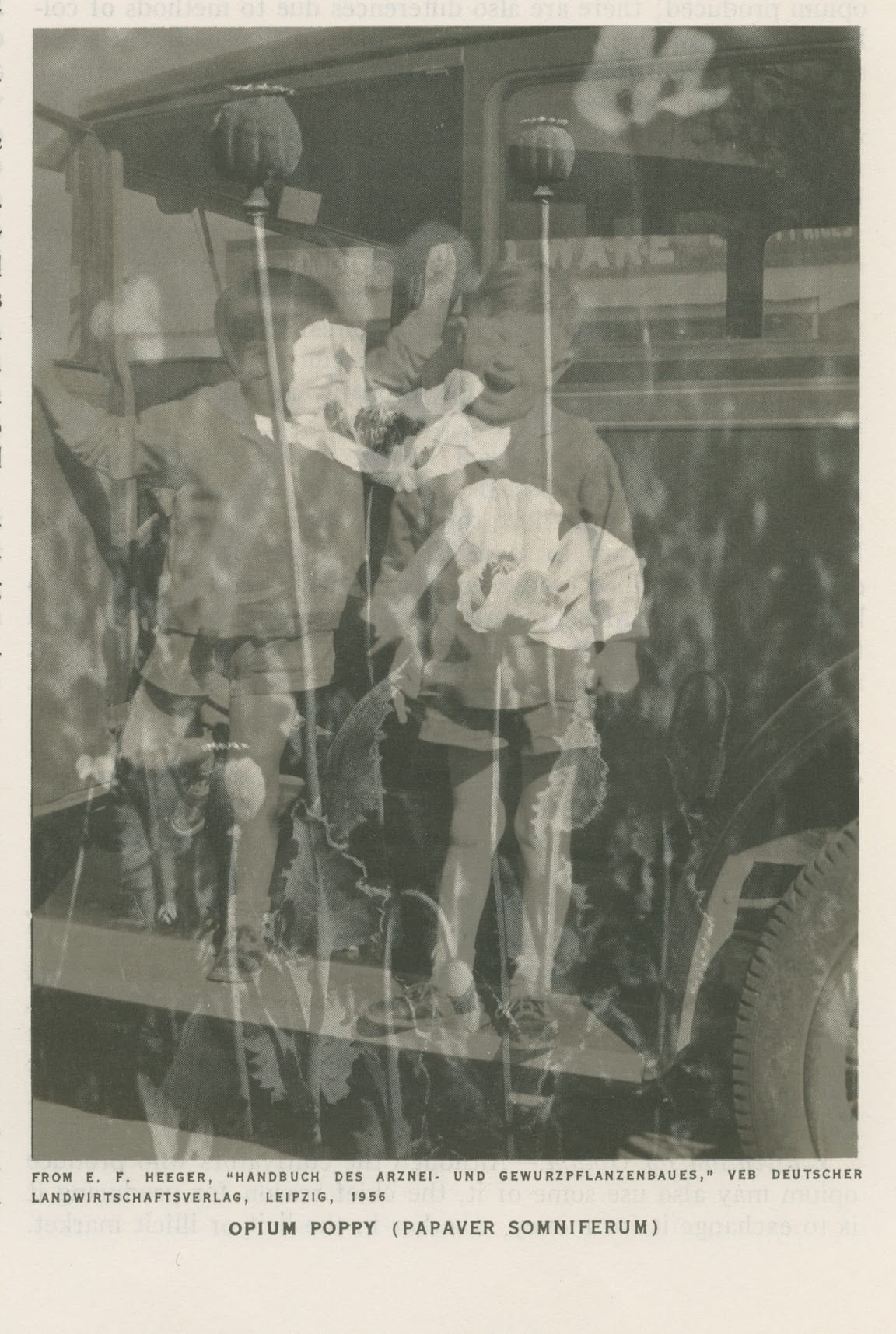 Emily Lesch, Two Boys, film
Emily Lesch, Two Boys, film
Finally, for anyone who might be interested in pursuing a career in photography or the arts more broadly, what advice would you give them based on your own experiences?
Just take pictures! We’re so lucky to have all this technology at our fingertips. That sometimes frustrates me because almost everyone’s got a phone these days, and most of them come with pretty sweet cameras. You don’t need all the fancy equipment, a degree, or anything like that.
I would love to emphasize the fact that going to school and learning from other artists provides so much benefit. I mean, I didn’t think I needed it at first. I was like, “I don’t need to do that, it’s just photography. I can teach myself!” And you totally can! But working with other artists, learning from them, has been such a game changer for me. There’s just so much you can’t learn on your own.
So yeah, just start taking pictures and try to learn from a true artist!
– – –
As I develop my notes from my talk with Emily Lesch, I’m struck by her passion and creativity in the field of photography. At just 22 years old she has an impressive range of experience with different mediums and techniques.
Emily’s upcoming show at the Three Legged Goat in Pflugerville, TX is sure to be an exciting event for photography enthusiasts and art lovers alike. Her use of archival images and sculptural elements to create new works is a testament to her innovative approach to the medium. I encourage everyone to check out her website and Instagram to see some of her stunning pieces and keep up with her future endeavors.
Website:https://emilylesch.wp.txstate.edu
Instagram: https://www.instagram.com/elesch_photography/
Three Legged Goat:
June 27th through July 30th
https://threeleggedgoattx.com
200 E Pecan St # 5, Pflugerville, TX 78660
(512) 968-0386
